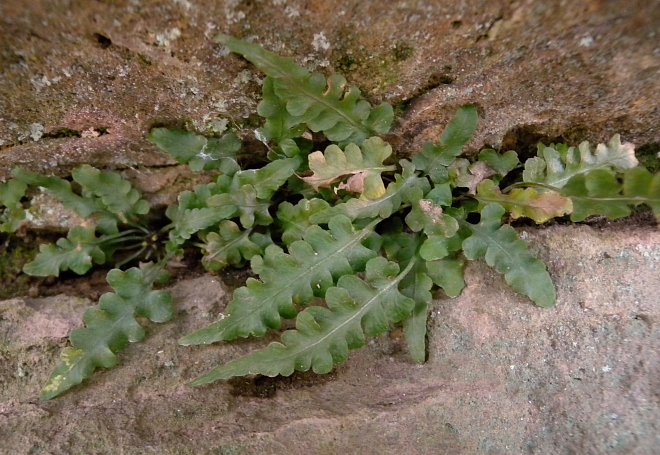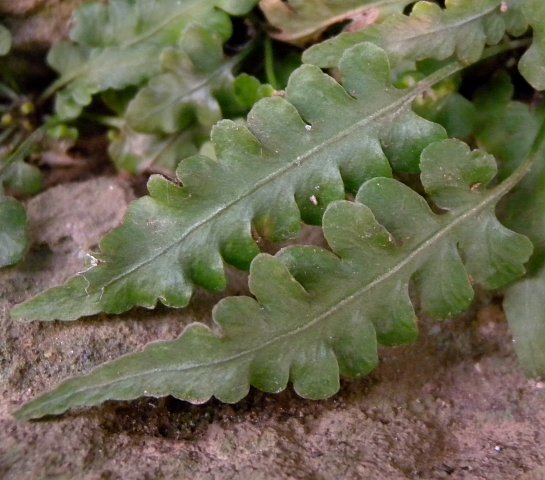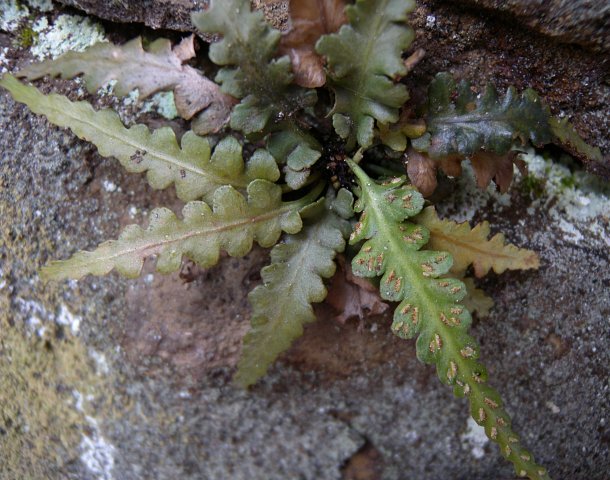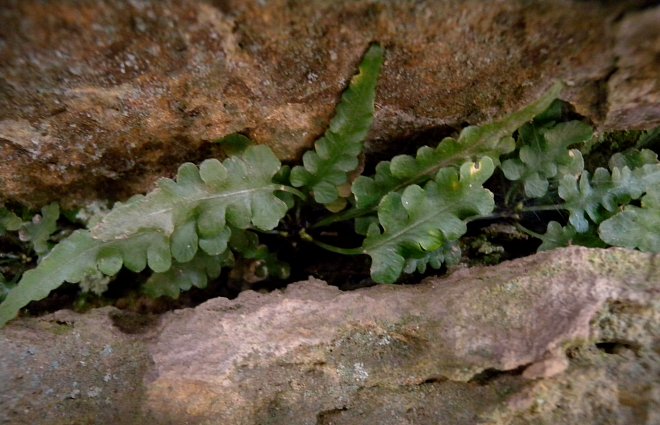
The leaf bases are indented between the basal lobes (or basal leaflets, when they are present), while the leaf tips are rounded to long, narrow, and slightly sinuous. The lobes disappear toward the leaf tips. The upper leaf surface is medium green or olive green and glabrous, while the lower leaf surface is about the same color or slightly more pale and either minutely and sparsely hairy or glabrous. The rachis of each leaf is green. The slender petioles are 1-4" long and mostly green, except toward their bases, where they are brown or black. The sori (spore-bearing structures) are located on the leaf undersides where the lobes occur. These sori are linear to slightly curved; they have indusia (protective membranes) attached along one side. The tiny spores of this fern are distributed by the wind. The root system consists of a rootstalk that is either vertical or short-creeping; the rootstalk has slender fibrous roots below.

Cultivation: This fern requires medium shade, crevices of a vertical rock formation that is acidic (e.g., sandstone), and high humidity in an area that is protected from the wind. Because of these demanding requirements, it is not normally cultivated.
Range & Habitat: The native Lobed Spleenwort is uncommon in the Shawnee Hills of southern Illinois, while in the rest of the state it is rare (see Distribution Map). Illinois is located near the northwestern range-limit of this fern; it is found primarily in the Appalachian Mountains. The habitat of this fern consists of crevices in vertical rock formations in protected areas, such as large ravines, north-facing cliffs, or rocky canyons. The rocky material in these habitats typically consists of sandstone. This fern is found in high quality natural areas.

Faunal Associations: The larvae of a fly, Phytoliriomyza felti, mine the leaves of this fern, while an aphid, Amphorophora ampullata, sucks sap from the foliage (Spencer & Steyskal, 1986; Needham et al., 1928; Hottes & Frison, 1931; Blackman & Eastop, 2013). Because this fern is found in relatively dark locations that are difficult to access, and its leaves are small in size, deer and other vertebrate herbivores rarely browse on it.
Photographic Location: Crevices of a sandstone rock formation in west-central Indiana.

Comments: This small fern is easy to overlook, and so it may be more common than official records indicate. Lobed Spleenwort (Asplenium pinnatifidum) can be distinguished from the Walking Fern (Asplenium rhizophyllum) by the presence of lateral lobes on its leaves, while the leaves of the latter fern have neither lobes nor leaflets. Lobed Spleenwort differs from other Spleenwort species (Asplenium spp.) by the absence, or near absence, of true leaflets on its leaves (a single pair of basal leaflets sometimes occurs). Other Spleenwort species have 2 or more pairs of leaflets on their leaves. Lobed Spleenwort is considered a naturally occurring hybrid of the Walking Fern and Mountain Spleenwort (Asplenium montanum). This latter fern does not occur in Illinois. Because its spores are usually fertile, rather than abortive, Lobed Spleenwort is regarded as a distinct species that is able to reproduce itself. This fern is able to hybridize with several other Spleenwort species, producing such offspring as Trudell's Spleenwort (Asplenium × trudellii), Grave's Spleenwort (Asplenium × gravesii), Kentucky Spleenwort (Asplenium × kentuckiense), and others. However, the spores of these hybrid species are usually abortive.